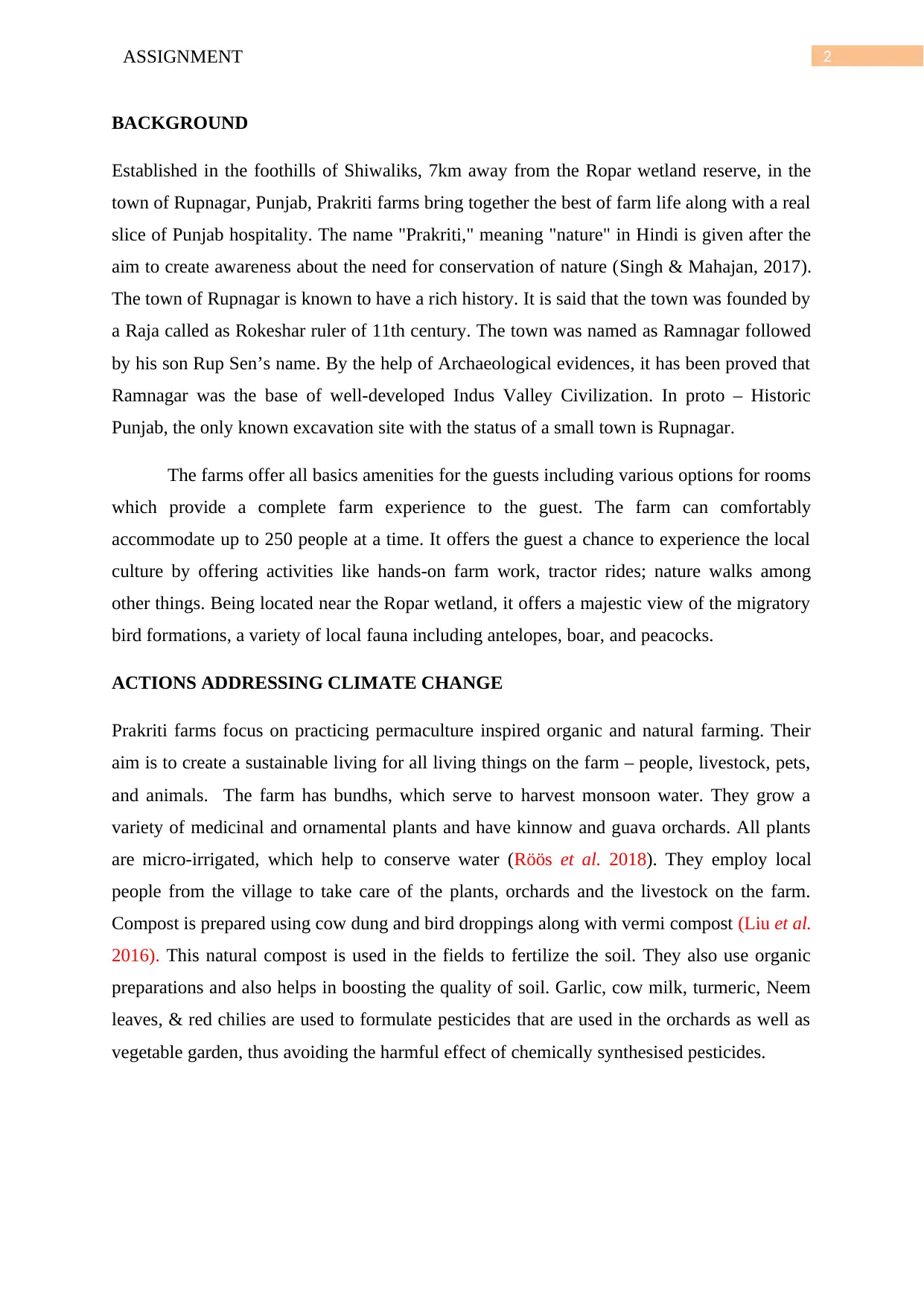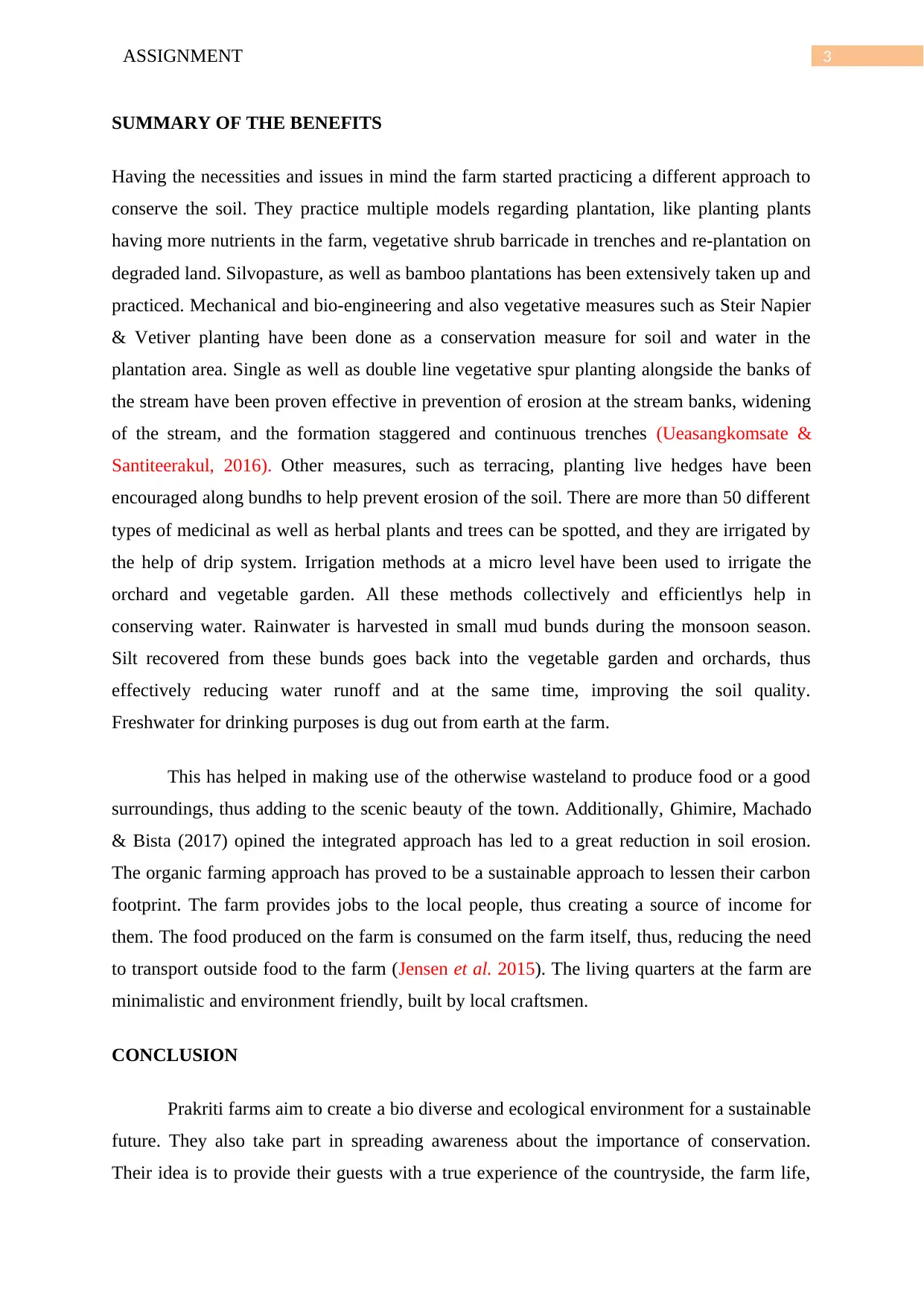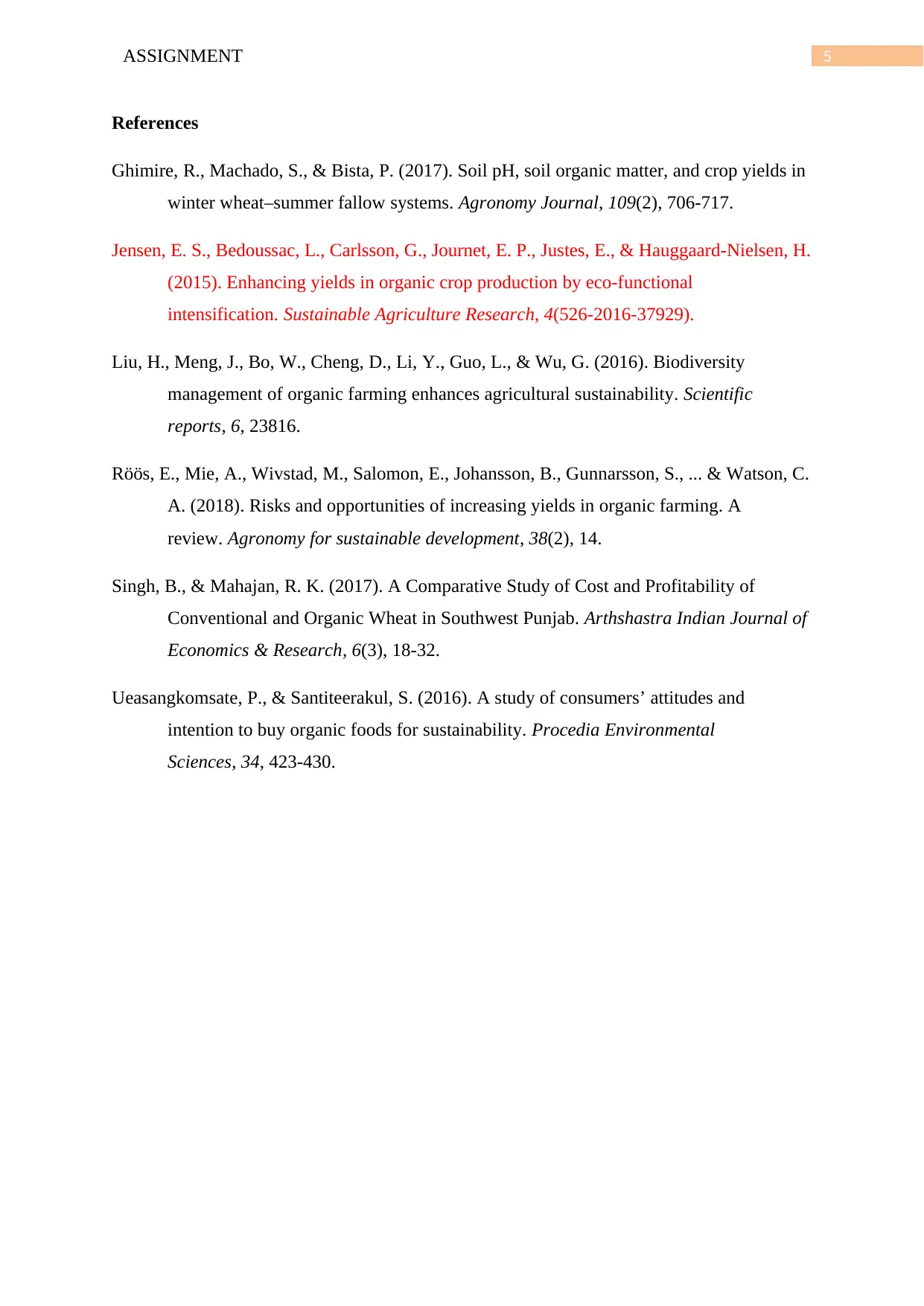Case Study of Prakriti Farms: Sustainable Agriculture and Conservation
VerifiedAdded on 2023/04/21
|5
|1242
|381
Case Study
AI Summary
This case study examines Prakriti Farms, an eco-friendly establishment in Rupnagar, Punjab, committed to sustainable agriculture and conservation. The farm employs permaculture-inspired organic farming, harvesting monsoon water through bundhs, micro-irrigation, and natural compost made from cow dung and vermi compost. Prakriti Farms uses organic pesticides and various soil conservation techniques, including vegetative shrub barricades, silvopasture, and terracing, to prevent soil erosion and improve soil quality. The farm also focuses on water conservation, rainwater harvesting, and providing employment to local villagers. By adopting an integrated approach, Prakriti Farms minimizes its carbon footprint, promotes biodiversity, and offers guests a unique experience of farm life while emphasizing the importance of sustainability. Desklib provides access to similar case studies and study resources for students.

Running Head: ASSIGNMENT
ASSIGNMENT
ASSIGNMENT
Secure Best Marks with AI Grader
Need help grading? Try our AI Grader for instant feedback on your assignments.

2ASSIGNMENT
BACKGROUND
Established in the foothills of Shiwaliks, 7km away from the Ropar wetland reserve, in the
town of Rupnagar, Punjab, Prakriti farms bring together the best of farm life along with a real
slice of Punjab hospitality. The name "Prakriti," meaning "nature" in Hindi is given after the
aim to create awareness about the need for conservation of nature (Singh & Mahajan, 2017).
The town of Rupnagar is known to have a rich history. It is said that the town was founded by
a Raja called as Rokeshar ruler of 11th century. The town was named as Ramnagar followed
by his son Rup Sen’s name. By the help of Archaeological evidences, it has been proved that
Ramnagar was the base of well-developed Indus Valley Civilization. In proto – Historic
Punjab, the only known excavation site with the status of a small town is Rupnagar.
The farms offer all basics amenities for the guests including various options for rooms
which provide a complete farm experience to the guest. The farm can comfortably
accommodate up to 250 people at a time. It offers the guest a chance to experience the local
culture by offering activities like hands-on farm work, tractor rides; nature walks among
other things. Being located near the Ropar wetland, it offers a majestic view of the migratory
bird formations, a variety of local fauna including antelopes, boar, and peacocks.
ACTIONS ADDRESSING CLIMATE CHANGE
Prakriti farms focus on practicing permaculture inspired organic and natural farming. Their
aim is to create a sustainable living for all living things on the farm – people, livestock, pets,
and animals. The farm has bundhs, which serve to harvest monsoon water. They grow a
variety of medicinal and ornamental plants and have kinnow and guava orchards. All plants
are micro-irrigated, which help to conserve water (Röös et al. 2018). They employ local
people from the village to take care of the plants, orchards and the livestock on the farm.
Compost is prepared using cow dung and bird droppings along with vermi compost (Liu et al.
2016). This natural compost is used in the fields to fertilize the soil. They also use organic
preparations and also helps in boosting the quality of soil. Garlic, cow milk, turmeric, Neem
leaves, & red chilies are used to formulate pesticides that are used in the orchards as well as
vegetable garden, thus avoiding the harmful effect of chemically synthesised pesticides.
BACKGROUND
Established in the foothills of Shiwaliks, 7km away from the Ropar wetland reserve, in the
town of Rupnagar, Punjab, Prakriti farms bring together the best of farm life along with a real
slice of Punjab hospitality. The name "Prakriti," meaning "nature" in Hindi is given after the
aim to create awareness about the need for conservation of nature (Singh & Mahajan, 2017).
The town of Rupnagar is known to have a rich history. It is said that the town was founded by
a Raja called as Rokeshar ruler of 11th century. The town was named as Ramnagar followed
by his son Rup Sen’s name. By the help of Archaeological evidences, it has been proved that
Ramnagar was the base of well-developed Indus Valley Civilization. In proto – Historic
Punjab, the only known excavation site with the status of a small town is Rupnagar.
The farms offer all basics amenities for the guests including various options for rooms
which provide a complete farm experience to the guest. The farm can comfortably
accommodate up to 250 people at a time. It offers the guest a chance to experience the local
culture by offering activities like hands-on farm work, tractor rides; nature walks among
other things. Being located near the Ropar wetland, it offers a majestic view of the migratory
bird formations, a variety of local fauna including antelopes, boar, and peacocks.
ACTIONS ADDRESSING CLIMATE CHANGE
Prakriti farms focus on practicing permaculture inspired organic and natural farming. Their
aim is to create a sustainable living for all living things on the farm – people, livestock, pets,
and animals. The farm has bundhs, which serve to harvest monsoon water. They grow a
variety of medicinal and ornamental plants and have kinnow and guava orchards. All plants
are micro-irrigated, which help to conserve water (Röös et al. 2018). They employ local
people from the village to take care of the plants, orchards and the livestock on the farm.
Compost is prepared using cow dung and bird droppings along with vermi compost (Liu et al.
2016). This natural compost is used in the fields to fertilize the soil. They also use organic
preparations and also helps in boosting the quality of soil. Garlic, cow milk, turmeric, Neem
leaves, & red chilies are used to formulate pesticides that are used in the orchards as well as
vegetable garden, thus avoiding the harmful effect of chemically synthesised pesticides.

3ASSIGNMENT
SUMMARY OF THE BENEFITS
Having the necessities and issues in mind the farm started practicing a different approach to
conserve the soil. They practice multiple models regarding plantation, like planting plants
having more nutrients in the farm, vegetative shrub barricade in trenches and re-plantation on
degraded land. Silvopasture, as well as bamboo plantations has been extensively taken up and
practiced. Mechanical and bio-engineering and also vegetative measures such as Steir Napier
& Vetiver planting have been done as a conservation measure for soil and water in the
plantation area. Single as well as double line vegetative spur planting alongside the banks of
the stream have been proven effective in prevention of erosion at the stream banks, widening
of the stream, and the formation staggered and continuous trenches (Ueasangkomsate &
Santiteerakul, 2016). Other measures, such as terracing, planting live hedges have been
encouraged along bundhs to help prevent erosion of the soil. There are more than 50 different
types of medicinal as well as herbal plants and trees can be spotted, and they are irrigated by
the help of drip system. Irrigation methods at a micro level have been used to irrigate the
orchard and vegetable garden. All these methods collectively and efficientlys help in
conserving water. Rainwater is harvested in small mud bunds during the monsoon season.
Silt recovered from these bunds goes back into the vegetable garden and orchards, thus
effectively reducing water runoff and at the same time, improving the soil quality.
Freshwater for drinking purposes is dug out from earth at the farm.
This has helped in making use of the otherwise wasteland to produce food or a good
surroundings, thus adding to the scenic beauty of the town. Additionally, Ghimire, Machado
& Bista (2017) opined the integrated approach has led to a great reduction in soil erosion.
The organic farming approach has proved to be a sustainable approach to lessen their carbon
footprint. The farm provides jobs to the local people, thus creating a source of income for
them. The food produced on the farm is consumed on the farm itself, thus, reducing the need
to transport outside food to the farm (Jensen et al. 2015). The living quarters at the farm are
minimalistic and environment friendly, built by local craftsmen.
CONCLUSION
Prakriti farms aim to create a bio diverse and ecological environment for a sustainable
future. They also take part in spreading awareness about the importance of conservation.
Their idea is to provide their guests with a true experience of the countryside, the farm life,
SUMMARY OF THE BENEFITS
Having the necessities and issues in mind the farm started practicing a different approach to
conserve the soil. They practice multiple models regarding plantation, like planting plants
having more nutrients in the farm, vegetative shrub barricade in trenches and re-plantation on
degraded land. Silvopasture, as well as bamboo plantations has been extensively taken up and
practiced. Mechanical and bio-engineering and also vegetative measures such as Steir Napier
& Vetiver planting have been done as a conservation measure for soil and water in the
plantation area. Single as well as double line vegetative spur planting alongside the banks of
the stream have been proven effective in prevention of erosion at the stream banks, widening
of the stream, and the formation staggered and continuous trenches (Ueasangkomsate &
Santiteerakul, 2016). Other measures, such as terracing, planting live hedges have been
encouraged along bundhs to help prevent erosion of the soil. There are more than 50 different
types of medicinal as well as herbal plants and trees can be spotted, and they are irrigated by
the help of drip system. Irrigation methods at a micro level have been used to irrigate the
orchard and vegetable garden. All these methods collectively and efficientlys help in
conserving water. Rainwater is harvested in small mud bunds during the monsoon season.
Silt recovered from these bunds goes back into the vegetable garden and orchards, thus
effectively reducing water runoff and at the same time, improving the soil quality.
Freshwater for drinking purposes is dug out from earth at the farm.
This has helped in making use of the otherwise wasteland to produce food or a good
surroundings, thus adding to the scenic beauty of the town. Additionally, Ghimire, Machado
& Bista (2017) opined the integrated approach has led to a great reduction in soil erosion.
The organic farming approach has proved to be a sustainable approach to lessen their carbon
footprint. The farm provides jobs to the local people, thus creating a source of income for
them. The food produced on the farm is consumed on the farm itself, thus, reducing the need
to transport outside food to the farm (Jensen et al. 2015). The living quarters at the farm are
minimalistic and environment friendly, built by local craftsmen.
CONCLUSION
Prakriti farms aim to create a bio diverse and ecological environment for a sustainable
future. They also take part in spreading awareness about the importance of conservation.
Their idea is to provide their guests with a true experience of the countryside, the farm life,

4ASSIGNMENT
along with stressing the importance of a sustainable approach. They aim to expand their idea
even further in the future.
along with stressing the importance of a sustainable approach. They aim to expand their idea
even further in the future.
Secure Best Marks with AI Grader
Need help grading? Try our AI Grader for instant feedback on your assignments.

5ASSIGNMENT
References
Ghimire, R., Machado, S., & Bista, P. (2017). Soil pH, soil organic matter, and crop yields in
winter wheat–summer fallow systems. Agronomy Journal, 109(2), 706-717.
Jensen, E. S., Bedoussac, L., Carlsson, G., Journet, E. P., Justes, E., & Hauggaard-Nielsen, H.
(2015). Enhancing yields in organic crop production by eco-functional
intensification. Sustainable Agriculture Research, 4(526-2016-37929).
Liu, H., Meng, J., Bo, W., Cheng, D., Li, Y., Guo, L., & Wu, G. (2016). Biodiversity
management of organic farming enhances agricultural sustainability. Scientific
reports, 6, 23816.
Röös, E., Mie, A., Wivstad, M., Salomon, E., Johansson, B., Gunnarsson, S., ... & Watson, C.
A. (2018). Risks and opportunities of increasing yields in organic farming. A
review. Agronomy for sustainable development, 38(2), 14.
Singh, B., & Mahajan, R. K. (2017). A Comparative Study of Cost and Profitability of
Conventional and Organic Wheat in Southwest Punjab. Arthshastra Indian Journal of
Economics & Research, 6(3), 18-32.
Ueasangkomsate, P., & Santiteerakul, S. (2016). A study of consumers’ attitudes and
intention to buy organic foods for sustainability. Procedia Environmental
Sciences, 34, 423-430.
References
Ghimire, R., Machado, S., & Bista, P. (2017). Soil pH, soil organic matter, and crop yields in
winter wheat–summer fallow systems. Agronomy Journal, 109(2), 706-717.
Jensen, E. S., Bedoussac, L., Carlsson, G., Journet, E. P., Justes, E., & Hauggaard-Nielsen, H.
(2015). Enhancing yields in organic crop production by eco-functional
intensification. Sustainable Agriculture Research, 4(526-2016-37929).
Liu, H., Meng, J., Bo, W., Cheng, D., Li, Y., Guo, L., & Wu, G. (2016). Biodiversity
management of organic farming enhances agricultural sustainability. Scientific
reports, 6, 23816.
Röös, E., Mie, A., Wivstad, M., Salomon, E., Johansson, B., Gunnarsson, S., ... & Watson, C.
A. (2018). Risks and opportunities of increasing yields in organic farming. A
review. Agronomy for sustainable development, 38(2), 14.
Singh, B., & Mahajan, R. K. (2017). A Comparative Study of Cost and Profitability of
Conventional and Organic Wheat in Southwest Punjab. Arthshastra Indian Journal of
Economics & Research, 6(3), 18-32.
Ueasangkomsate, P., & Santiteerakul, S. (2016). A study of consumers’ attitudes and
intention to buy organic foods for sustainability. Procedia Environmental
Sciences, 34, 423-430.
1 out of 5
Your All-in-One AI-Powered Toolkit for Academic Success.
+13062052269
info@desklib.com
Available 24*7 on WhatsApp / Email
![[object Object]](/_next/static/media/star-bottom.7253800d.svg)
Unlock your academic potential
© 2024 | Zucol Services PVT LTD | All rights reserved.